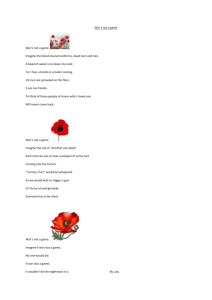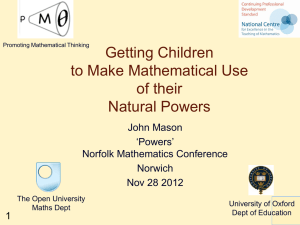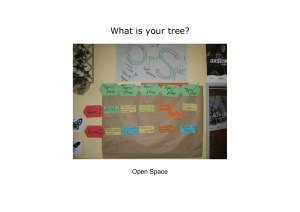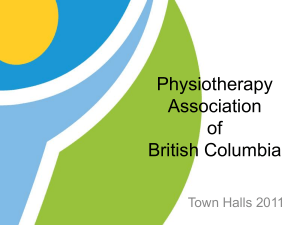Imagine That! - The Open University
advertisement
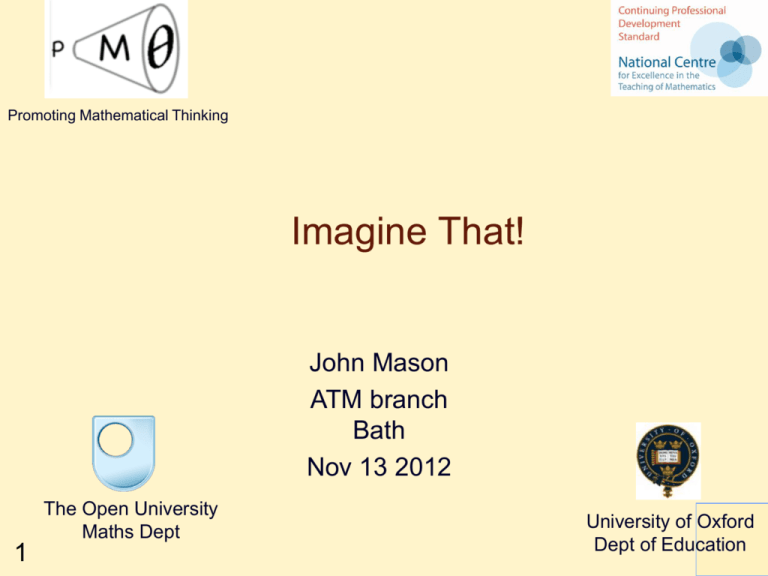
Promoting Mathematical Thinking Imagine That! John Mason ATM branch Bath Nov 13 2012 The Open University Maths Dept 1 University of Oxford Dept of Education Conjectures 2 Everything said here today is a conjecture … to be tested in your experience The best way to sensitise yourself to learners … … is to experience parallel phenomena yourself So, what you get from this session is what you notice happening inside you! Tasks 3 Tasks promote Activity; Activity involves Aactions; Actions generate Experience; – but one thing we don’t learn from experience is that we don’t often learn from experience alone It is not the task that is rich … – but whether it is used richly Necker Cube 4 Stacked Cubes 5 What Do You See? 6 Say What You See Sketch what you think you saw Compare with what others drew How did you go about it? 7 Triangular Reflections Imagine a triangle Now imagine a more interesting triangle! – Label the vertices A, B and C 8 Choose a point P in the plane somewhere Reflect P in the point A to get the point PA Reflect PA in the point B to get the point PAB Reflect PAB in the point C to get the point PABC What is the geometric relation between P and PABC? Repeat starting from PABC to end with PABCABC Now what is the relation between P and PABCABC? Triangle Movements 9 Imagine a triangle Now imagine a more interesting triangle! Mark the midpoints of its edges (A, B, C) Rotate a copy of your trianglethrough 180° around the point A and note where the copy B’ of B is. Now rotate a copy of the copy through 180° around the point B’, noting the image A’ of A. Keep rotating alternately about the new positions of B and of A to produce a collection of triangles. Ride & Tie 10 Imagine that you and a friend have a single horse (bicycle) and that you both want to get to a town some distance away. In common with folks in the 17th century, one of you sets off on the horse while the other walks. At some point the first dismounts, ties the horse and walks on. When you get to the horse you mount and ride on past your friend. Then you too tie the horse and walk on… Supposing you both ride faster than you walk but at different speeds, how do you decide when and where to tie the horse so that you both arrive at your destination at the same time? Ride & Tie Imagine, then draw a diagram! Seeking Relationships / 11 Does the diagram make sense (meet the constraints)? Gasket Sequences 12 Two + Two 2 +2 =2 x 2 1 1= + x 3 1 3 1 2 2 with 1 1= + x the 4 13 4 13 grain 1 1= + x 5 1 5 1 4 13 across the grain +1 1 = x 1 1 - 1 4 1 1= + x 6 1 6 1 5 5 ... 1 1 2 + 1 = 2 x 11 1 1 1= + x 1 17 1 17 16 16 1 1 = + x √17 1 √17 1 17 - 1 17 - 1 Watch What You Do! - 1 With and Across the Grain 14 Extending & Varying 15 Polygon Perimeter Projections 16 Imagine a quadrilateral (irregular) Imagine a point P traversing the perimeter of the quadrilateral at uniform speed. Imagine the projections of P onto a horizontal and a vertical axis … More or Less grids Perimeter Area More Same Less More Same Less 17 With as little change as possible from the original! Put your hand up when you can see … 18 Something that is 3/5 of something else Something that is 2/5 of something else Something that is 2/3 of something else Something that is 5/3 of something else What other fraction-actions can you see? How did your attention shift? Put your hand up when you can see … Something that is 1/4 – 1/5 of something else Did you look for something that is 1/4 of something else and for something that is 1/5 of the same thing? What did you have to do with your attention? Can you generalise? 19 1 1 1 - = c -1 c c ( c -1) 1 1 c-r - = r c rc Two Journeys Which journey over the same distance at two different speeds takes longer: – One in which both halves of the distance are done at the specified speeds – One in which both halves of the time taken are done at the specified speeds time distance d d t1 = t2 = 2v1 2v2 d d t = + 2v1 2v2 20 t t d1 = v1 d2 = v2 2 2 2d t= v1 + v2 Named Ratios Now take a named ratio (eg density) and recast this task in that language Which mass made up of two densities has the larger volume: – One in which both halves of the mass have the fixed densities – One in which both halves of the volume have the same densities? 21 Counting Out In a selection ‘game’ you start at the left and count forwards and backwards until you get to a specified number (say 37). Which object will you end on? A B C D E 1 2 3 4 5 9 8 7 6 10 … If that object is elimated, you start again from the ‘next’. Which object is the last one left? 22 23 If I have included visibility in my list of values to be saved, it is to give warning of the danger we run in losing a basic human faculty: the power of bringing visions into focus with our eyes shut, of bringing forth forms and colours from the lines of black letters on a white page, and in fact of thinking in terms of images. I have in mind some possible pedagogy of the imagination that would accustom us to control our own inner vision without suffocating it or letting it fall, on the other hand, into confused, ephemeral daydreams, but would enable the images to crystallize into a well-defined, memorable, and self-sufficient form, the icastic form. This is of course a form of pedagogy that we can only exercise upon ourselves, according to methods invented for the occasion and with unpredictable results. (Calvino 1988, p. 92). Six memos for the next millennium Outer & Inner Tasks Outer Task – – – – Inner Task – – – – – 24 What author imagines What teacher intends What students construe What students actually do What powers might be used? What themes might be encountered? What connections might be made? What reasoning might be called upon? What personal dispositions might be challenged? Imagining Basis of Geometric Thinking Basis of Anticipating Basis of ‘Realising’ Basis of Accessing & Enriching Example Spaces Basis of Planning Geometric Images ATM 25
